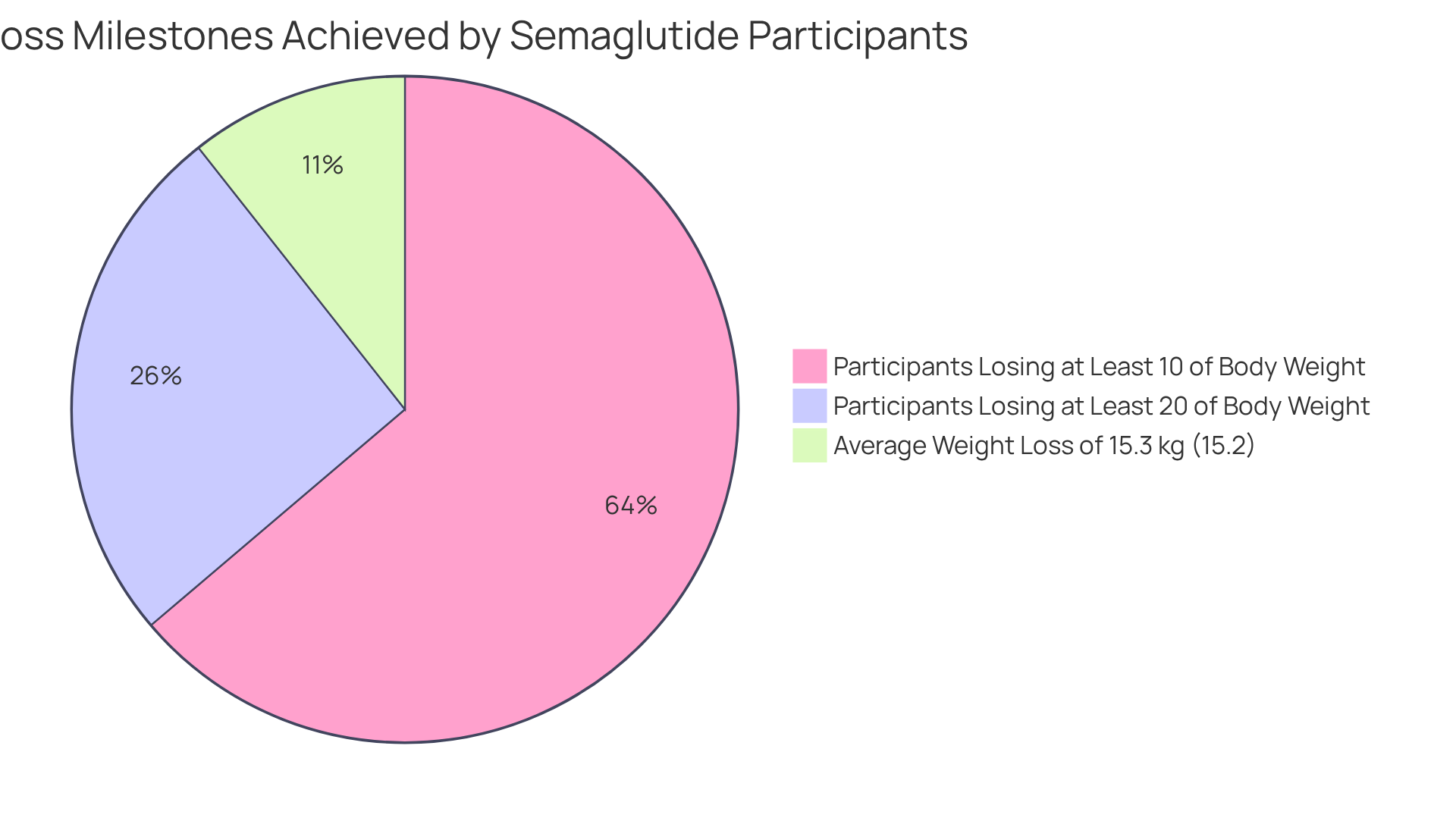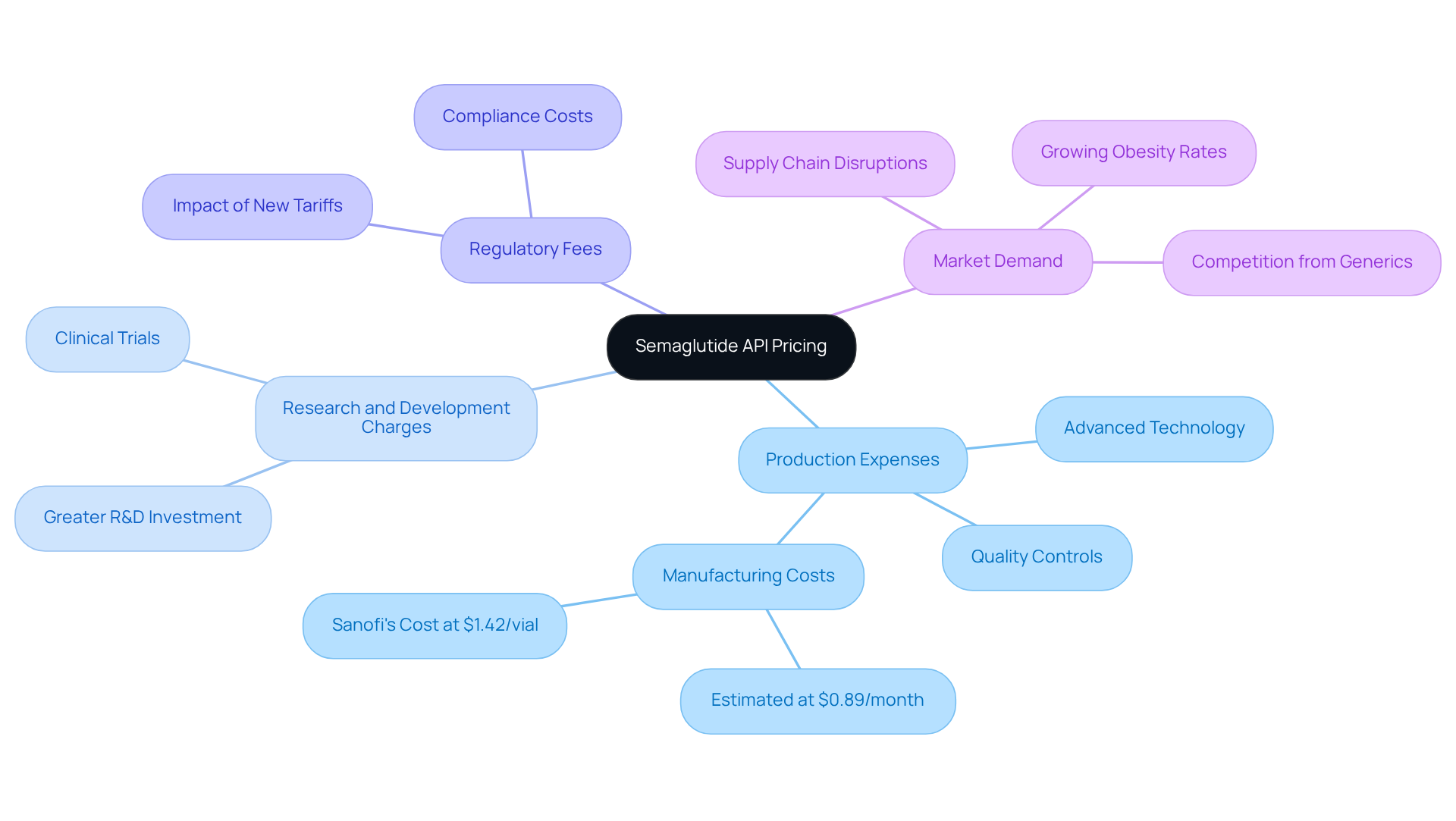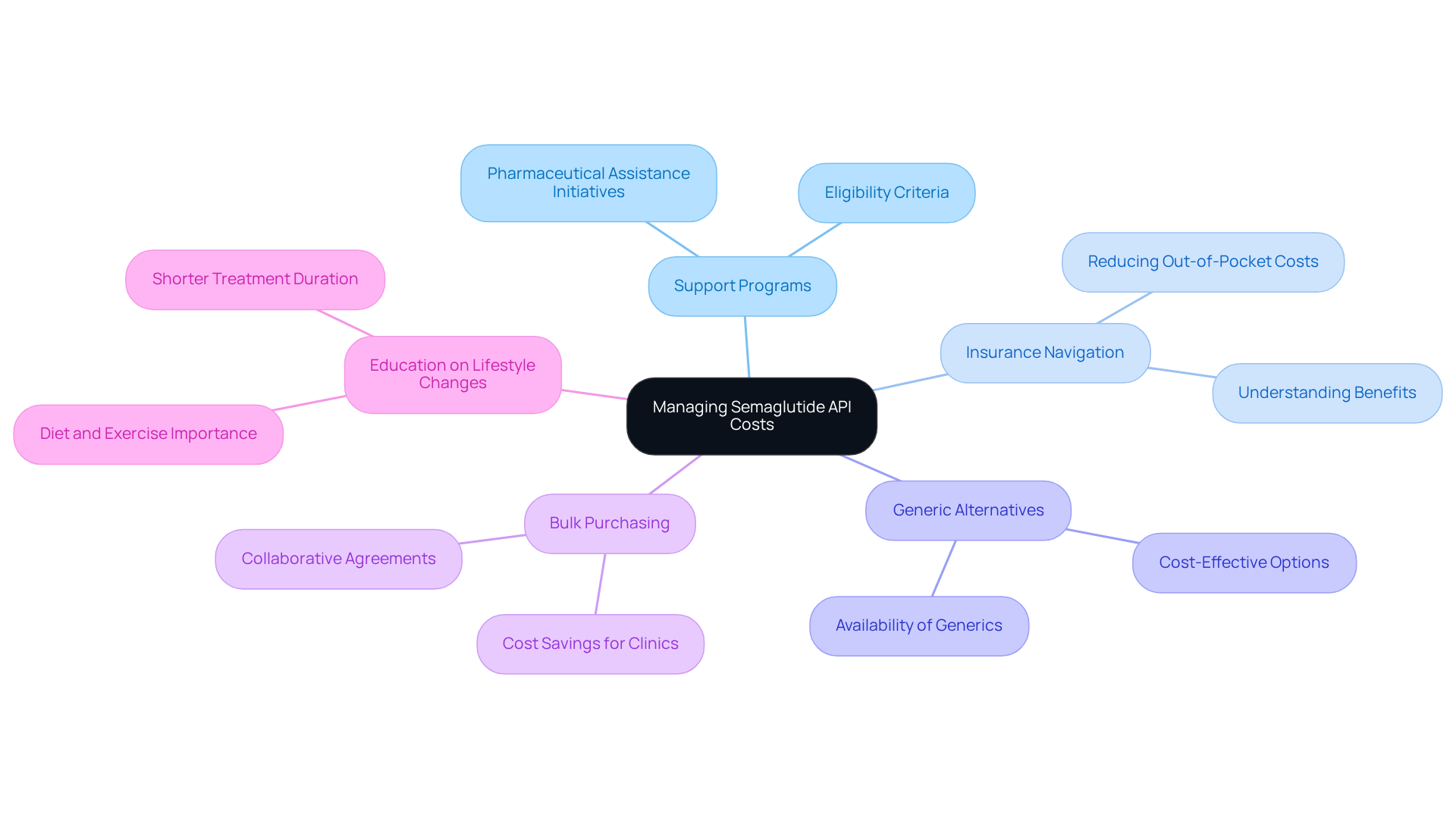Overview
This article seeks to illuminate the price of semaglutide API and its profound impact on weight management. Understanding the challenges you may face in your weight loss journey is essential, and we want to highlight how effective semaglutide can be in promoting weight loss and addressing obesity.
Various factors, including production costs and market demand, play a crucial role in determining pricing. It’s important to recognize that high medication costs can create barriers to access for patients like you, ultimately affecting your treatment choices and health outcomes.
Together, we can explore these challenges and look for solutions. By addressing these concerns, we aim to empower you with knowledge and encourage you to advocate for your health. Remember, you are not alone in this journey, and there are paths to support and access that can lead to positive outcomes.
Introduction
Understanding the nuances of semaglutide—a glucagon-like peptide-1 (GLP-1) receptor agonist—reveals its pivotal role in weight management and diabetes control. As many individuals embark on the challenging journey of combating obesity, the potential for significant weight loss through this medication brings forth important questions about accessibility and affordability.
How can the complexities of semaglutide API pricing affect your access to treatment options? What strategies might you consider to navigate these financial hurdles?
Exploring these themes not only sheds light on the medication’s benefits but also offers valuable insights for those seeking support in their weight loss journeys. Together, we can achieve your goals.
Define Semaglutide and Its Role in Weight Management
Semaglutide is a glucagon-like peptide-1 (GLP-1) receptor agonist, authorized for managing type 2 diabetes and supporting long-term body management. It mimics the GLP-1 hormone, which plays a crucial role in appetite regulation and insulin secretion. By enhancing feelings of fullness and reducing appetite, this medication can help individuals achieve significant weight loss when combined with lifestyle changes, such as improved nutrition and increased physical activity.
Imagine being able to attain an average weight loss of roughly 15.3 kg, which corresponds to about 15.2% of your body mass. Clinical trials have shown that individuals using semaglutide can achieve this remarkable result. In the STEP 5 trial, participants experienced an average reduction of 15.2% after 104 weeks, with 36.1% of participants losing at least 20% of their initial body mass. Furthermore, an impressive 90% of patients shed at least 10% of their body mass, highlighting the effectiveness of this treatment.
This positions semaglutide as a powerful ally in the ongoing battle against obesity, offering significant benefits for those seeking effective management solutions for their bodies. But the advantages don’t stop there. This treatment has also been linked to improvements in cardiometabolic risk factors, such as lowering blood sugar levels and enhancing insulin sensitivity. This establishes semaglutide as a comprehensive approach to addressing obesity, aligning beautifully with a holistic method for personalized weight loss solutions.
Together, we can navigate your weight loss journey, and with the support of semaglutide, you can take meaningful steps towards achieving your goals. Remember, you are not alone in this journey, and we’re here for you every step of the way.
Analyze Factors Affecting Semaglutide API Pricing
When discussing the semaglutide API price, several factors come into play. We understand that navigating these complexities can be overwhelming. Key elements include:
- Production expenses
- Research and development charges
- Regulatory fees
- Market demand
The manufacturing process is intricate, requiring advanced technology and strict quality controls, which significantly contributes to the overall cost.
Moreover, the competitive landscape also plays a crucial role. The presence of generic alternatives and market exclusivity periods can influence pricing strategies. Have you considered how economic factors, such as supply chain disruptions and the global demand for diabetes and obesity treatments, impact the final cost of medications? These elements are vital in establishing the semaglutide API price you may encounter.
We’re here for you as you explore your options. Understanding these factors can empower you to make informed decisions on your weight loss journey. Together, we can navigate these challenges and find the best solutions for your needs.
Evaluate the Impact of Pricing on Patient Access and Treatment Choices
The substantial expense of medication can create significant barriers for patients seeking access and treatment options. Many individuals face overwhelming out-of-pocket costs, especially in areas where insurance coverage is limited or non-existent. This financial burden often leads to treatment discontinuation or avoidance, which can adversely impact overall health outcomes. It’s important to recognize that disparities in access frequently align with socioeconomic status, geographic location, and insurance coverage, resulting in inequities in the availability of effective management therapies for body composition.
For instance, while brand-name medications can range from $900 to over $1,200 monthly, compounded alternatives from providers like LookMeds offer more budget-friendly options at $149 for tablets and $199 for injections, especially when considering the semaglutide api price. These pricing differences underscore the necessity for healthcare providers to understand these dynamics and advocate for policies that enhance access to essential weight management solutions, particularly regarding the semaglutide api price. At Minimal, we do not accept insurance; however, we do accept HSA/FSA payments for our services, providing a flexible payment option that can help alleviate some financial burdens for our clients.
Our commitment to being fully HIPAA compliant ensures that your personal health information is securely handled and protected. Moreover, research indicates that reducing the cost of medication by 50% significantly enhances its cost-effectiveness, making it a more feasible choice for individuals. Addressing these financial obstacles is crucial for ensuring fair treatment options for everyone, ultimately leading to improved health outcomes. Together, we can navigate these challenges and work towards achieving your health goals.
Implement Strategies for Managing Semaglutide API Costs in Practice
Managing the costs associated with semaglutide API can feel overwhelming, but there are several supportive strategies that healthcare providers can consider to help ease this burden:
-
Support Programs: Many pharmaceutical companies offer assistance initiatives that can significantly lower expenses for those who qualify. These programs are designed to provide relief and make treatment more accessible.
-
Insurance Navigation: Helping individuals understand their insurance benefits and potential coverage options can lead to reduced out-of-pocket costs. This guidance can make a big difference in managing expenses.
-
Generic Alternatives: When available, prescribing generic versions of the medication can offer a more affordable option for patients. This choice can help alleviate financial stress while still providing effective treatment.
-
Bulk Purchasing: Clinics and healthcare facilities might explore bulk purchasing agreements to lower costs. This collaborative approach can lead to significant savings for everyone involved.
-
Education on Lifestyle Changes: Emphasizing the importance of diet and exercise can enhance the effectiveness of semaglutide. By focusing on these lifestyle changes, individuals may find that they need a shorter duration of treatment, which can help reduce overall costs, including the semaglutide API price.
Together, we can navigate these challenges and find the best solutions for your journey. Remember, we’re here for you every step of the way.
Conclusion
Semaglutide emerges as a vital ally in the journey of weight management, offering a compassionate approach to addressing obesity through its unique role as a GLP-1 receptor agonist. This medication not only assists in regulating appetite but also holds promise in enhancing overall health outcomes by improving cardiometabolic risk factors. When combined with lifestyle modifications, semaglutide can lead to meaningful weight loss, making it an invaluable resource for those striving to reach their health goals.
This article explores the complexities surrounding semaglutide API pricing, shedding light on various factors that influence costs, including:
- Production expenses
- Regulatory fees
- Market demand
Understanding these dynamics is crucial, as they directly affect patient access to this essential treatment. Furthermore, the discussion on treatment costs highlights significant disparities in access, emphasizing the importance of advocating for policies that improve the affordability and availability of effective weight management solutions.
Ultimately, addressing the financial barriers associated with semaglutide is vital for enhancing patient outcomes and ensuring equitable access to treatment. By leveraging supportive strategies, such as:
- Patient assistance programs
- Education on lifestyle changes
Healthcare providers can help ease the burden of costs. This collaborative approach not only empowers individuals on their weight loss journeys but also nurtures a more inclusive healthcare environment where everyone has the opportunity to achieve their desired health outcomes. Together, we can move towards a healthier future.
Frequently Asked Questions
What is semaglutide?
Semaglutide is a glucagon-like peptide-1 (GLP-1) receptor agonist that is authorized for managing type 2 diabetes and supporting long-term body management.
How does semaglutide work in weight management?
Semaglutide mimics the GLP-1 hormone, which regulates appetite and insulin secretion. It enhances feelings of fullness and reduces appetite, helping individuals achieve significant weight loss when combined with lifestyle changes like improved nutrition and increased physical activity.
What weight loss results have been observed in clinical trials with semaglutide?
Clinical trials have shown that individuals using semaglutide can achieve an average weight loss of about 15.3 kg, or approximately 15.2% of their body mass. In the STEP 5 trial, participants experienced an average reduction of 15.2% after 104 weeks, with 36.1% losing at least 20% of their initial body mass, and 90% shedding at least 10%.
What additional health benefits does semaglutide provide?
Semaglutide has been linked to improvements in cardiometabolic risk factors, such as lowering blood sugar levels and enhancing insulin sensitivity, making it a comprehensive approach to addressing obesity.
How can individuals navigate their weight loss journey with semaglutide?
Individuals can take meaningful steps towards achieving their weight loss goals with the support of semaglutide, alongside lifestyle changes. They are encouraged to seek guidance and support throughout their journey.




















